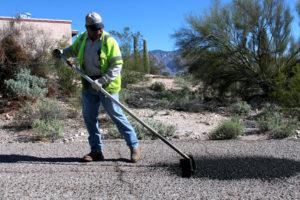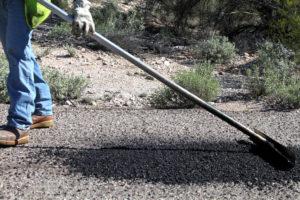
Campaign promises. Propositions. Complaining. Damages. Injuries. What do just some of these aspects each have in common? The crumbling infrastructure of Tucson roads.
In 2013, the Old Pueblo was ranked fifth worst in the country for the conditions of roads by TRIP, a national transportation research group. This crumbling infrastructure effects Tucson’s community, elected representatives and the economy.
“I hit a pothole in my car and the pothole was so bad that it busted my tire,” said Adriana Chairez, Tucson resident, who at various times repaired tires on all four of her vehicles because of the potholes scattered across Tucson. “I was travelling at 40 miles per hour. It popped my tire.”
After the damage to her vehicle’s tire, Chairez, who drives her kids to school, began taking a different route to avoid the damaging roads.
“It’s draining, having to settle with the fact that you’re paying your taxes, you’re not seeing the money go to fixing the roads,” said Chairez.
She tried using Pima County’s pothole damage reimbursement program but after going back and forth with Pima County, filing forms, submitting emails and re-signing forms, Chairez gave up.
To receive such a reimbursement, residents must file a claim. If someone had reported the pothole, the county is liable. But it is more likely that the county didn’t know. According to Pima County Administrator Chuck Huckelberry, 80 percent of the claims are rejected because there’s no evidence that the county was ever notified that a pothole was there.

Paul Cunningham, Tucson City Councilman for Ward 2, said funding is the biggest challenge he and his fellow council members face when working to fix Tucson’s roads.
Cunningham said even just filling potholes with sealant can cost up to $100,000 per lane-mile, depending on the nature of the engineering required and the placement.
“It’s no easy task to fix roads,” Cunningham said.
Proposition 409, approved November 2012, provided $100 million for failing conditions of roads.
Over the course of five years, the Tucson Department of Transportation employed private sector construction companies to repair and over 200 miles of Tucson roads. According to the city, 173 miles have completed.
“That $100 million has helped us to make a substantial dent in the back log of road improvements we have,” Cunningham said. “But the $100 million only goes so far and even if we were allotted another $100 million, we’d still be playing catchup after five years.”
In 2013, Tucson was ranked fifth in the county’s worst roads. But in 2015, that changed and Tucson didn’t even make the list. The reason? Cunningham said proposition 409.
“At this point, by this time in 2018, in the last five year period, every single major road will be resurfaced,” Cunningham said.
Huckelberry said the Pima County’s money comes from the allocation of Highway User Revenue funds.
“That’s all the money we have,” Huckelberry said. “We have no bonds that have been approved for pavement repair, similar to the city. All of our money comes from our operating budget.”
While there has been improvements, the unsatisfied mindset of the community regarding roads won’t ever change, according to Cunningham.
“No matter what you do, it rains and monsoons here every year,” Cunningham said. “Every year that’s going to form more potholes.”
Cunningham said Tucson drivers are more likely to remember the one pothole they hit over the smooth road they drove on.
“They’re going to remember that one damn pothole,” Cunningham said.
Cunningham said that despite the negative mindset, he works to use the limited funds available to “change and improve every road I can.”
Roads, parks, police and fire are all equally the top priorities within every city, according to Cunningham.
“You can do the secondary things, but you’ve got to be sure you’re doing your best at the first things first,” Cunningham said.

Jared Jobe, general manager at Firestone Complete Auto Care, said the quality of roads is one of the most common contributors to vehicle damage.
“The damage can vary from everything from a minor crack to a damaged tire, to severe front end suspension issues,” Jobe said. “Based off of damage from potholes or road conditions directly, we see one or two a week.”
The cost to repair damages caused by the condition of roads varies depending on the severity of the damage, according to Jobe.
“It could be anywhere from a tire replacement for a couple hundred bucks to suspension damage or wheel damage, where you can get up to the higher eight to nine hundred dollar range,” Jobe said. “I have seen a few of them where the damage was very significant, where it cost anywhere between $1200 and $1500. It just depends on the vehicle and the model.”
Normally, Jobe said he would recommend six months to a year for alignments, but said he and his team specifically recommend six months because of the roads in Tucson and Pima County.
“Prime example, Broadway Blvd between Camino Seco and Harrison,” Jobe said. “That road is horrible.”
This stretch of road is the same stretch that has continually damaged Chairez’s car, forcing her to take a different route.
There are approximately 2134 miles of roads in Pima County that require attention and cost approximately $250 million for a one-time fix repair, according to Annabelle Valenzuela, community relations program manager at the Pima County Department of Transportation.
“Due to funding limitations, we are not able to address all of the roads all at once,” Valenzuela said. “Fortunately, this fiscal year 2016-2017, there is a pavement preservation program to resurface some of the roads in Pima County.”

The pavement preservation program will use micro seal and new asphalt on varying roads including Nogales Highway, 1st Avenue, and Thornydale, just to name a few.
“There are over 60 percent of our roads in unincorporated Pima County that are in poor or failing condition,” Valenzuela said.
Huckelberry said Pima County has designed a Super Crew specifically dedicated to fixing potholes.
“It’s really an attempt to pay attention to road repair,” Huckelberry said. “We’re really kind of in an emergency action plan to respond to places where there could be public safety hazards.”
The only way to fix the detreating roads and craters in Pima County’s streets? A gas tax, according to Huckelberry. The current gas tax in Arizona is 18 cents. Huckelberry is proposing to add another 10 cents to the tax. If the proposition were to be put on the ballot, Tucsonans could expect to pay a 28 cent tax every time they fill up.

While Huckelberry said it’s a significant increase, it could fix the problem. But if the proposition doesn’t pass, Huckelberry said it’s on the voters.
“If it’s rejected, then we end up saying, ‘the voters have spoken and apparently don’t mind bad roads.’”
The city and county’s roads aren’t just being noticed by the community, but nationally too.
According to the American Society of Civil Engineers (ASCE)’s Infrastructure Report Card, Arizona received a C, or mediocre grade, in 2015 for the state’s infrastructure.
“Fewer than 50 percent of Arizona’s roadway needs can be addressed with expected baseline revenues. Arizona’s and the national primary funding source, a gasoline sales tax, is not keeping up with needs, and the diversion of transportation related taxes and fees to other areas is resulting in a funding shortfall that won’t allow Arizona to keep up with projected growth and commerce,” according to ASCE.
While there are efforts to fix the crumbling infrastructure of Tucson and Pima County’s roads, Huckelberry said, “We’ve put a pretty good Band-Aid on the problem, but that’s all it is right now.”
Amanda Oien is a reporter for the Arizona Sonora News, a service from the School of Journalism with the University of Arizona. Contact her at [email protected]
Click here for high resolution photos.


